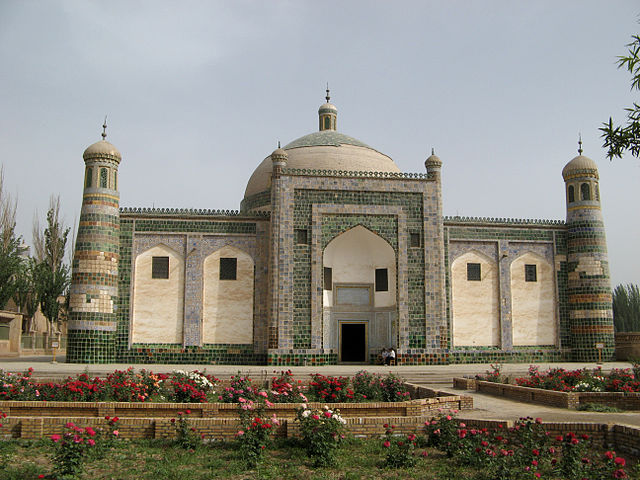
Aba Khoja Mausoleum
Kashgar, Xinjiang Province (map)

|
Aba Khoja MausoleumKashgar, Xinjiang Province (map) |
The oasis town of Kashgar was the gateway to Persia and the West, located near the present western border of China, where the southern and middle branches of the Silk Road join at the western end of the Taklamakan desert. Like most of Xinjiang, this area was garrisoned by China in Han times, independent during the Islamic period (9th through 18th centuries), and part of China from the Qing dynasty (17th century) onwards.
The Khojas were a family of religious leaders and local rulers of Kashgar, during the Qing dynasty. The mausoleum now named after Aba Khoja (also spelled "Apak Khoja," with many variants) was originally built in 1640 by his father. Although it looks like a mosque (prayer hall) from the front, the building is actually a mazar (mausoleum), like the Taj Mahal in India. The building is an example of Timurid (central Asian) Islamic architecture, with squat tiled minarets, a large dome (next page), and an iwan-style niche entrance. Its floor plan is a symmetrical square, with minarets on all four corners. The rear and side walls lack the iwan, but are otherwise similar to the front wall seen here.
The Aba Khoja mausoleum is celebrated locally, although incorrectly, as the burial place of Xiangfei, the "fragrant concubine" of many legends, who fought against the Qing but was captured and taken to Beijing; there she was installed against her will in the harem of Emperor Qianlong, but refused to sleep with him, and was eventually poisoned. Although actually buried in Chengde, Xiangfei is locally identified with Ikparhan, the wife of one of Aba Khoja's grandsons, who is buried in the mausoleum.

|

|